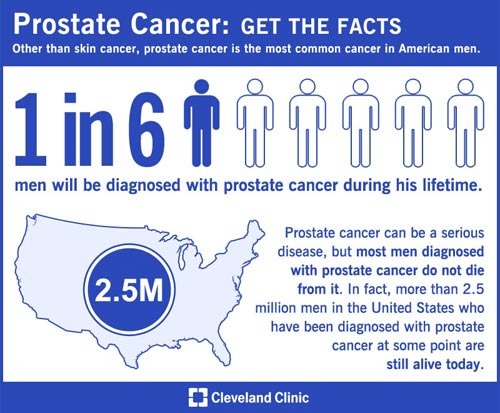
“Prostate cancer is a form of cancer that develops in the prostate, a gland in the male reproductive system. Most prostate cancers are slow growing;[1] however, there are cases of aggressive prostate cancers.[2] The cancer cells may metastasize (spread) from the prostate to other parts of the body, particularly the bones and lymph nodes. Prostate cancer may cause pain, difficulty in urinating, problems during sexual intercourse, or erectile dysfunction. Other symptoms can potentially develop during later stages of the disease.
Rates of detection of prostate cancers vary widely across the world, with South and East Asia detecting less frequently than in Europe, and especially the United States.[3] Prostate cancer tends to develop in men over the age of fifty.[4] Globally it is the sixth leading cause of cancer-related death in men[5] (in the United States it is the second).[4] Prostate cancer is most common in the developed world with increasing rates in the developing world.[5] However, many men with prostate cancer never have symptoms, undergo no therapy, and eventually die of other unrelated causes. Many factors, including genetics and diet, have been implicated in the development of prostate cancer.
The presence of prostate cancer may be indicated by symptoms, physical examination, prostate-specific antigen (PSA), or biopsy. Prostate-specific antigen testing increases cancer detection but does not decrease mortality.[6] The United States Preventive Services Task Force in 2012 recommended against screening for prostate cancer using the PSA testing, due to the risk of over-diagnosis and over-treatment with most prostate cancer remaining asymptomatic.[7] The USPSTF concludes that the potential benefit of testing does not outweigh the expected harms.[7]
 Management strategies for prostate cancer should be guided by the severity of the disease. Many low-risk tumors can be safely followed with active surveillance. Curative treatment generally involves surgery, various forms of radiation therapy, or, less commonly, cryosurgery; hormonal therapy and chemotherapy are generally reserved for cases of advanced disease (although hormonal therapy may be given with radiation in some cases). Several studies suggest that masturbation reduces the risk of prostate cancer.[8][9][10]
Management strategies for prostate cancer should be guided by the severity of the disease. Many low-risk tumors can be safely followed with active surveillance. Curative treatment generally involves surgery, various forms of radiation therapy, or, less commonly, cryosurgery; hormonal therapy and chemotherapy are generally reserved for cases of advanced disease (although hormonal therapy may be given with radiation in some cases). Several studies suggest that masturbation reduces the risk of prostate cancer.[8][9][10]
The age and underlying health of the man, the extent of metastasis, appearance under the microscope and response of the cancer to initial treatment are important in determining the outcome of the disease. The decision whether or not to treat localized prostate cancer (a tumor that is contained within the prostate) with curative intent is a patient trade-off between the expected beneficial and harmful effects in terms of patient survival and quality of life.”
From Wikipedia, the free encyclopedia
